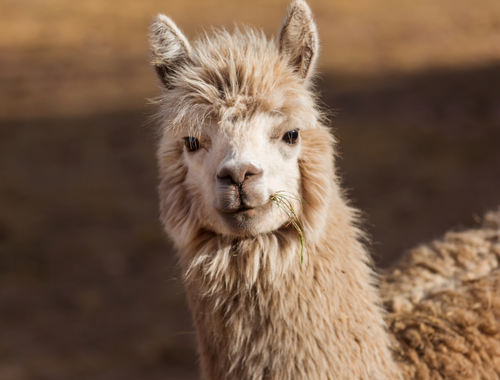
From a glance llamas and alpacas may seem very similar and if you don’t know the differences to look for, they can easily be mistaken for each other.
They form part of the camelid species (camel family) that originate and are still prevalent in South America. Alpacas (Vicugna pacos) are the domesticated lineage of the vicuña (Vicugna vicugna). While llamas (Lama glama) are the domesticated descendant of the guanaco (Lama guanicoe). Both species are predominantly found in Peru and in Bolivia.
Although they are soft on the eyes, both alpacas and llamas have played their part in serving humans for transport, their meat, and wool/ fleece production.

What is the difference between an alpaca and a llama?
According to the Britannica encyclopedia, there are key differences in appearance such as their size, hair, and the shape of their faces.
How can you tell llamas and alpacas apart?
Alpacas are much smaller than llamas, with a shoulder height of around 90 centimeters, and weighing between 55-65kg. While llamas can be as high as 120 centimeters at the shoulders and weigh up to 113kg. Therefore, llamas are the better choice to use as pack animals and meat for humans.
It’s all in the ears: alpacas have smaller ears that are spear-shaped, while llamas have longer ears, described as banana-shaped.
Llamas have longer faces, while alpacas have blunted face shapes.
Hair: Alpacas have different coloured fleece, ranging in 22 colours from black to silver and rose gray and white, from mahogany brown to light fawn and champagne. Llamas can be black, white, brown, gray, spotted, and even speckled. Alpacas have finer fleece that is superior to llamas for wool production.
Are alpacas nicer than llamas?
Alpacas are not necessarily nicer than llamas. However, due to llamas’ size and use for transportation as pack animals, llamas are mistreated or overloaded, they have been known to spit, kick and behave stubbornly – such as lying down and not wanting to move. Alpacas have a better reputation as they appear to be calmer and timider in nature.
Is llama milk a thing?
Yes. Llamas and alpacas produce milk, but there is no accurate data on human consumption of these. A recent study in 2021 reviewed the nutritional properties of camelids. They concluded that llama milk is lower in fat and salt than cow’s milk, but higher in calcium and phosphate levels. Milk from alpacas is higher in protein and lower in fat, especially saturated fat. Both llama and alpaca milk does not contain β-1actoglobulin, one of the main allergens found in cow’s milk causing cow’s milk protein allergy. It may therefore be a useful alternative to other mammalian milk; however, further studies are needed to determine the exact composition. Human infants should still have breastmilk from their mothers and progress to other suitable dairy alternatives while the nutritional composition of South American camelids is studied. There is however no harm in adding it to adult human diets but do consider the higher lactose content in comparison to cow’s milk if you struggle with lactose intolerance.
Can you eat alpacas?
Yes, alpacas are an important meat source for families living in the rural Andes of South America. In Peru, data shows that around half a million alpacas are slaughtered for meat annually.
Can you ride an alpaca?
No, alpacas are too small to bear the weight of a human riding on them. Their bone structures are not as strong as their llama cousins and therefore humans should refrain from trying to ride them.
Alpacas and llamas are therefore woven from the same camelid family, but there are clear differences that make them unique. Whether they are kept as pets, for transportation, wool, or for meat consumption, they are exceptional animals that are both pleasant to look at as well as being beneficial to humans.












Leave a Reply